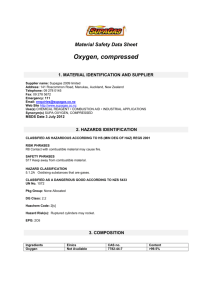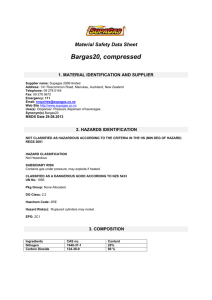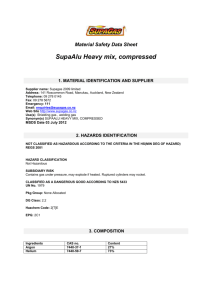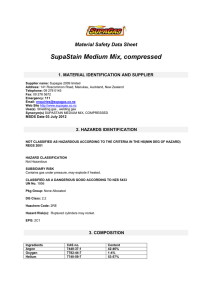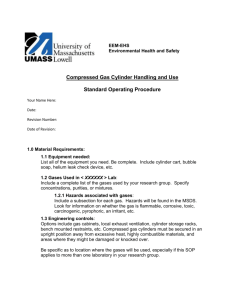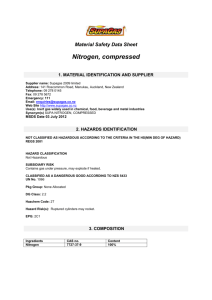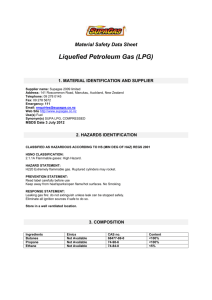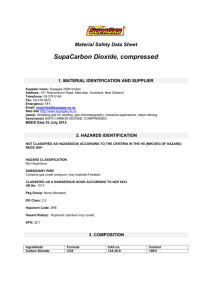Material Safety Data Sheet Lazer N Compressed (52KB
advertisement
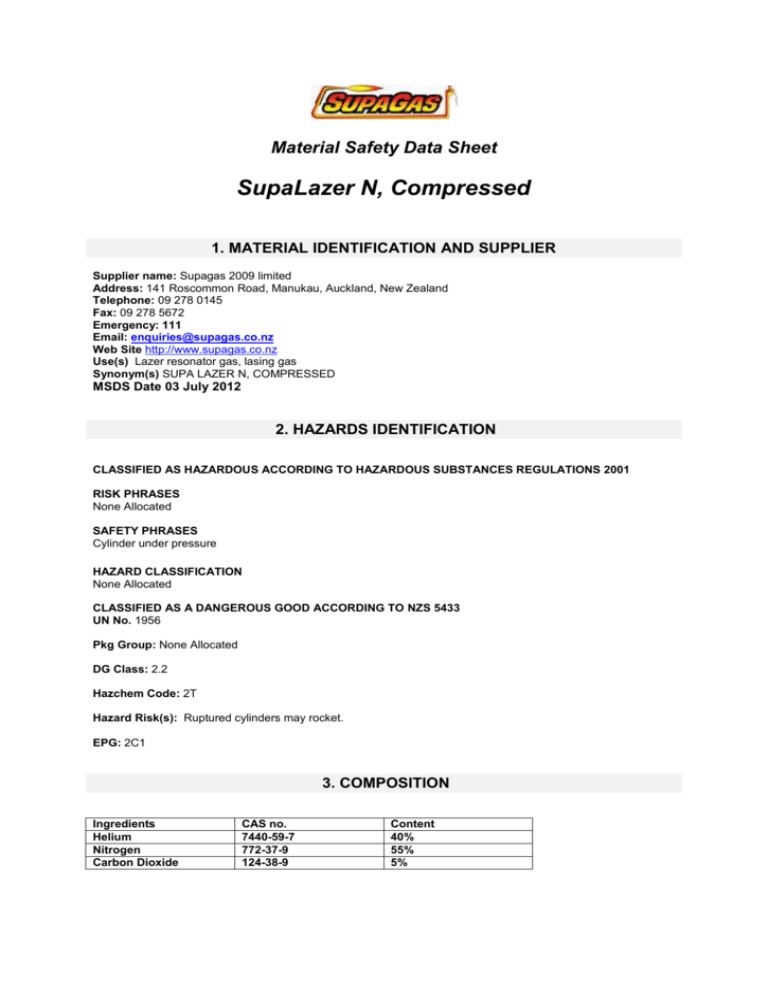
Material Safety Data Sheet SupaLazer N, Compressed 1. MATERIAL IDENTIFICATION AND SUPPLIER Supplier name: Supagas 2009 limited Address: 141 Roscommon Road, Manukau, Auckland, New Zealand Telephone: 09 278 0145 Fax: 09 278 5672 Emergency: 111 Email: enquiries@supagas.co.nz Web Site http://www.supagas.co.nz Use(s) Lazer resonator gas, lasing gas Synonym(s) SUPA LAZER N, COMPRESSED MSDS Date 03 July 2012 2. HAZARDS IDENTIFICATION CLASSIFIED AS HAZARDOUS ACCORDING TO HAZARDOUS SUBSTANCES REGULATIONS 2001 RISK PHRASES None Allocated SAFETY PHRASES Cylinder under pressure HAZARD CLASSIFICATION None Allocated CLASSIFIED AS A DANGEROUS GOOD ACCORDING TO NZS 5433 UN No. 1956 Pkg Group: None Allocated DG Class: 2.2 Hazchem Code: 2T Hazard Risk(s): Ruptured cylinders may rocket. EPG: 2C1 3. COMPOSITION Ingredients Helium Nitrogen Carbon Dioxide CAS no. 7440-59-7 772-37-9 124-38-9 Content 40% 55% 5% 4. FIRST AID MEASURES Eye Skin Inhalation Exposure is considered unlikely. irritation to the skin is considered unlikely. If inhaled, to remove the victim from the exposed area wear the correct self contained breathing apparatus to ensure there is no harm to the rescuer. Apply artificial respiration if not breathing. Provide oxygen if available. Ingestion Ingestion is considered unlikely. However, should ingestion occur, contact a Poison Information Centre on 0800764 766 (0800 POISON) or +643 479 7248 (New Zealand) or a doctor. Advice to Doctor Treat symptomatically 5. FIRE FIGHTING MEASURES Fire and Explosion Non flammable gas. Temperatures in a fire may cause cylinders to rupture and internal pressure relief devices to be activated. Call fire brigade. Do not approach cylinders suspected to be hot. Remove cool cylinders from the path of the fire if safe to do so. Ensure working area is well ventilated before re-use. Notify the manufacturer that you will be returning a faulty cylinder. Residual product will be disposed of when the cylinder is returned. Extinguishing Non flammable. Use water fog to cool containers from protected area. Flammability Non flammable Hazchem Code 2T 6. ACCIDENTAL RELEASE MEASURES Spillage GAS CYLINDERS: If the cylinder is leaking, eliminate all potential ignition sources and evacuate area of personnel. Inform manufacturer/supplier of leak. Wear appropriate Protective equipment and if safe to do so carefully move it to a well ventilated remote area, then allow to discharge. Do not attempt to repair leaking valve or cylinder safety devices. Personal protection: Do not smoke while handling this product. Persons moving cylinders should be provided with safety footwear, safety glasses and leather or PVC gloves. Full cover overalls are recommended. All personal protective equipment must be free from oil and grease. 7. STORAGE AND HANDLING Handling Before use carefully read the product label. Use of safe work practices are recommended to avoid eye or skin contact and inhalation. Observe good personal hygiene, including washing hands before eating. Prohibit eating, drinking and smoking in contaminated areas. Storage Do not store near sources of ignition or incompatible materials. Cylinders should be stored below 45º C in a secure area, upright and restrained to prevent cylinders from falling. Cylinders should also be stored in a dry, well ventilated area constructed of non-combustible material with firm level floor (preferably concrete), away from areas of heavy traffic and emergency exits. 8. EXPOSURE CONTROLS / PERSONAL PROTECTION Exposure Standards Carbon Dioxide TWA 5,000 ppm v/v STEL 30,000 ppm v/v. Helium is an Asphyxiant. Nitrogen is a simple Asyphixiant. No biological limit allocated. Biological Limit Values Engineering Controls Use only properly specified equipment which is suitable for this product, its pressure and temperature. Provide suitable extraction and ventilation for the influenced areas. Wear safety boots, leather gloves and safety glasses. Personal Protection Equipment 9. PHYSICAL AND CHEMICAL PROPERTIES Appearance : Colourless gas Odour: odourless/Tasteless PH: Not Available Vapour pressure: Not Available Vapour Density: Not Available Boiling point: -195.8ºc Melting point: not available Evaporation rate; not available Critical Temperature: -146.95ºc Solubility (Water) : Insoluble Specific gravity: Not Available % Volatiles : Not Available Flammability: Non Flammable Flash point: Not relevant Upper explosion limit: Not Relevant Lower explosion limit: not relevant Autoignition Temperature: not available Density: 1.185kg/m3 10. STABILITY AND REACTIVITY Material to Avoid Aluminim chrome and and Manganese dust may explode when heated in carbon dioxide. Incompatible with acryaldehide, azirdine, metal acetylides and sodium peroxide. Avoid heating cylinders. Decomposition May evolve toxic gases if heated to decomposition. Stability Stable under recommended conditions of storage. 11. TOXICOLOGICAL INFORMATION Health Hazard Summary Non irritant - non toxic gas. The respiratory and central nervous systems are primarily affected by gaseous oxygen. No health effects have been observed in humans exposed to concentrations up to 80 volume % oxygen for a few hours or up to 50 volume % for 24 hours. At pressures above 1 atmosphere hyperoxia may appear after 2 to 6 hours. Chronic exposure at normal or elevated pressure may cause severe thickening and scarring of lung tissues. Not carcinogenic or mutagenic. Eye Non irritating. Inhalation Non-irritant. . Skin Non irritating. Ingestion Due to product form, ingestion is considered highly unlikely. Toxicity Data Carbon Dioxide (124-38-9) LcLo (inhalation) 9pph/5 minutes (human) 12. ECOLOGICAL INFORMATION Environment No Known ecological damage caused by helium or nitrogen. When discharged in large quantities carbon dioxide constituent contributes to the greenhouse effect. Global warming factor (co2=1) 1 13. DISPOSAL CONSIDERATIONS Waste Disposal Cylinders should be returned to the manufacturer or supplier for disposal of contents. Legislation Dispose of in accordance with relevant local legislation. 14. TRANSPORT INFORMATION Transport Ensure cylinder is separated from driver and that outlet of relief device is not obstructed. Ensure the driver is aware of potential hazards and actions necessary in the event of an accident or emergency. Before commencing transporting of Cylinders ensure: containers are firmly secured. cylinder valve is closed and not leaking. there is adequate ventilation. compliance with applicable regulations has been achieved. CLASSIFIED AS A DANGEROUS GOOD ACCORDING TO NZS 5433 Shipping Name : Supa Lazer N, Compressed UN No. 1956 DG Class: 2.2 Pkg Group: None Allocated Hazchem Code: 2T Subsidiary Risk(s): None allocated EPG: 2C1 15. REGULATORY INFORMATION Group Name Supa Lazer N EPA Approval Number HSR002533 UN No. 1956 HSNO Controls: Hazardous Substances (Compressed Gases) Regulations 2004 Hazardous Substances (Tank Wagon and Transportable Containers) Regulations 2004 Compressed Gas Mixtures (Non-hazardous) Group Standard 2006 Approved Handler: Classified as non-hazardous under HSNO, Approved Handlers not required. 16. OTHER INFORMATION Additional Information This product is used in the manufacturer of steel for high precision work in cutting, welding and braising. APPLICATION METHOD: Gas regulator of suitable pressure and flow rating fitted to cylinder or manifold with low pressure gas distribution to equipment. ABBREVIATIONS: mg/m3 - Milligrams per cubic metre ppm - Parts Per Million TWA/ES - Time Weighted Average or Exposure Standard. CNS - Central Nervous System NOS - Not Otherwise Specified pH - relates to hydrogen ion concentration - this value will relate to a scale of 0 - 14, where 0 is highly acidic and 14 is highly alkaline. CAS# - Chemical Abstract Service number - used to uniquely identify chemical compounds. M - moles per litre, a unit of concentration. IARC - International Agency for Research on Cancer. HSNO –Hazardous substances and new organisms act 1996. PERSONAL PROTECTIVE EQUIPMENT GUIDELINES: The recommendation for protective equipment contained within this report is provided as a guide only. Factors such as method of application, working environment, quantity used, product concentration and the availability of engineering controls should be considered before final selection of personal protective equipment is made. HEALTH EFFECTS FROM EXPOSURE: It should be noted that the effects from exposure to this product will depend on several factors including: frequency and duration of use; quantity used; effectiveness of control measures; protective equipment used and method of application. Given that it is impractical to prepare a report which would encompass all possible scenarios, it is anticipated that users will assess the risks and apply control methods where appropriate. This MSDS summarises to our best knowledge, at the date of issue, the health and safety hazard information regarding this product and general guidance on how to safely handle the product in the workplace. All due care has been taken to include accurate and up-to-date information in this MSDS. Each user should read this MSDS and consider the information in the context of how the product will be handled and used in the workplace in conjunction with other products. If clarification or further information is needed to ensure that an appropriate risk assessment can be made, the user should contact Supagas 2009 Ltd. As far as lawfully possible, no liability for any loss, injury or damage (including consequential loss) which may be suffered or incurred by any person as a consequence of their reliance on the information contained in this MSDS can be accepted. Our responsibility for products sold is subject to our standard terms and conditions, a copy of which is available on request. This MSDS has been prepared in accordance with NZCIC Code of Practice – Preparation of Safety Data Sheets. This MSDS is subject to change without notice, for the latest version of this MSDS visit www.supagas.co.nz Reviewed 03 July 2012.
